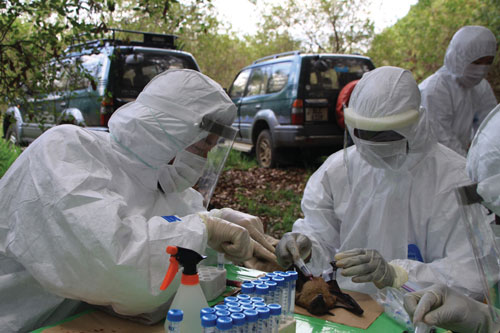Global Successes Surveillance of Viral Zoonoses
SCIENCE AND TECHNOLOGY RESEARCH PARTNERSHIP FOR SUSTAINABLE DEVELOPMENT PROGRAM (SATREPS)

AMED and the Japan International Cooperation Agency (JICA) are supporting the advancement of local education, technical capacity and diagnostic techniques for viral zoonoses such as Ebola and influenza in Zambia.
The study is one of 13 that AMED is currently conducting in the field of infectious disease control as part of SATREPS.
Led by Ayato Takada, Professor, Research Center for Zoonosis Control, Hokkaido University, the study involves surveys to identify reservoirs and transmission routes of viruses, so that future issues can be controlled locally.
Midway through the five-year research period, the study has produced a number of encouraging outcomes. Perhaps the most significant is the development of a rapid diagnosis kit for identifying Ebola cases. In addition, a number of potentially useful antibodies have been discovered, and diagnostic guidelines have been established to further raise the standard of local virology research and education.
As the study moves into the next phase, the team will continue its close cooperation with the School of Veterinary Medicine at the University of Zambia in order to reinforce and expand on current findings.
Ultimately, AMED hopes the study will contribute to the improvement of zoonosis control throughout Zambia and the rest of Africa.
 Concept
Concept
Develop capacity for research and education on viral zoonoses, and identify common carriers in order to predict emergence of zoonotic viral infections and accelerate diagnosis.
 Progress
Progress
Initial project goals were achieved midway through the five-year study. Outcomes include the development a rapid diagnosis kit for identifying the Ebola virus, including subtype. Moving forward, the project will reinforce and expand on current findings through more comprehensive testing.
 Collaborators
Collaborators
School of Veterinary Medicine, the University of Zambia; Research Center for Zoonosis Control, Hokkaido University
Last updated 09/20/18

